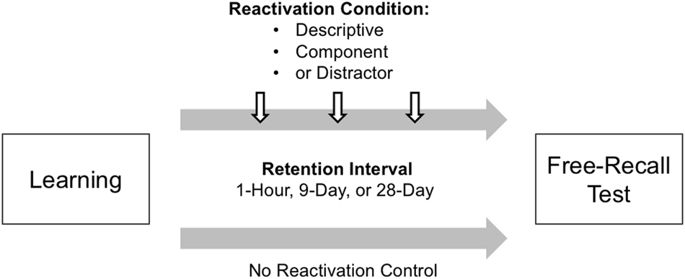npj Science of Learning ( IF 3.6 ) Pub Date : 2018-04-24 , DOI: 10.1038/s41539-018-0025-x Sydney MacLeod , Michael G. Reynolds , Hugo Lehmann

|
Memory reactivation is a process whereby cueing or recalling a long-term memory makes it enter a new active and labile state. Substantial evidence suggests that during this state the memory can be updated (e.g., adding information) and can become more vulnerable to disruption (e.g., brain insult). Memory reactivations can also prevent memory decay or forgetting. However, it is unclear whether cueing recall of a feature or component of the memory can benefit retention similarly to promoting recall of the entire memory. We examined this possibility by having participants view a series of neutral images and then randomly assigning them to one of four reactivation groups: control (no reactivation), distractor (reactivation of experimental procedures), component (image category reactivation), and descriptive (effortful description of the images). The experiment also included three retention intervals: 1 h, 9 days, and 28 days. Importantly, the participants received three reactivations equally spaced within their respective retention interval. At the end of the interval, all the participants were given an in-lab free-recall test in which they were asked to write down each image they remembered with as many details as possible. The data revealed that both the participants in the descriptive reactivation and component reactivation groups remembered significantly more than the participants in the control groups, with the effect being most pronounced in the 28-day retention interval condition. These findings suggest that memory reactivation, even component reactivation of a memory, makes memories more resistant to decay.
中文翻译:

反复记忆重新激活对遗忘的缓解作用
记忆重新激活是一个过程,通过该过程可以提示或调用长期记忆,从而使其进入新的活动和不稳定状态。大量证据表明,在此状态下,内存可以更新(例如,添加信息),并且变得更容易受到破坏(例如,脑部侮辱)。内存重新激活还可以防止内存衰减或遗忘。但是,不清楚提示内存的某个特征或组件的召回是否可以像促进整个内存的召回一样有益于保留。我们通过让参与者查看一系列中性图像,然后将它们随机分配给四个重新激活组之一来检验了这种可能性:控制组(不重新激活),干扰物(重新启动实验程序),组件(图像类别重新激活)和描述性(努力图片说明)。实验还包括三个保留间隔:1小时,9天和28天。重要的是,参与者在各自的保留间隔内均等间隔了三个重新激活。在时间间隔结束时,所有参与者都接受了实验室内免费召回测试,其中要求他们写下尽可能多的细节以记住他们所记住的每个图像。数据显示,描述性重新激活组和组件重新激活组的参与者都比对照组的参与者记忆力明显,在28天保留间隔条件下效果最为明显。这些发现表明,记忆再激活,甚至是记忆的成分再激活,都使记忆更能抵抗衰变。重要的是,参与者在各自的保留间隔内均等间隔了三个重新激活。在时间间隔结束时,所有参与者都接受了实验室内免费召回测试,其中要求他们写下尽可能多的细节以记住他们所记住的每个图像。数据显示,描述性重新激活组和组件重新激活组的参与者记忆力均明显强于对照组,在28天保留间隔条件下效果最为明显。这些发现表明,记忆再激活,甚至是记忆的成分再激活,都使记忆更能抵抗衰变。重要的是,参与者在各自的保留间隔内均等间隔了三个重新激活。在时间间隔结束时,所有参与者都接受了实验室内免费召回测试,其中要求他们写下尽可能多的细节以记住他们所记住的每个图像。数据显示,描述性重新激活组和组件重新激活组的参与者记忆力均明显强于对照组,在28天保留间隔条件下效果最为明显。这些发现表明,记忆的重新激活,甚至是记忆的成分重新激活,都使记忆更能抵抗衰变。所有参与者都接受了一次实验室内的免费召回测试,要求他们写下尽可能多的细节来记住他们所记住的每张图像。数据显示,描述性重新激活组和组件重新激活组的参与者记忆力均明显强于对照组,在28天保留间隔条件下效果最为明显。这些发现表明,记忆再激活,甚至是记忆的成分再激活,都使记忆更能抵抗衰变。所有参与者都接受了一次实验室内的免费召回测试,要求他们写下尽可能多的细节来记住他们所记住的每张图像。数据显示,描述性重新激活组和组件重新激活组的参与者记忆力均明显强于对照组,在28天保留间隔条件下效果最为明显。这些发现表明,记忆再激活,甚至是记忆的成分再激活,都使记忆更能抵抗衰变。数据显示,描述性重新激活组和组件重新激活组的参与者记忆力均明显强于对照组,在28天保留间隔条件下效果最为明显。这些发现表明,记忆再激活,甚至是记忆的成分再激活,都使记忆更能抵抗衰变。数据显示,描述性重新激活组和组件重新激活组的参与者记忆力均明显强于对照组,在28天保留间隔条件下效果最为明显。这些发现表明,记忆再激活,甚至是记忆的成分再激活,都使记忆更能抵抗衰变。











































 京公网安备 11010802027423号
京公网安备 11010802027423号